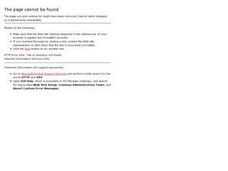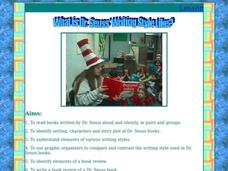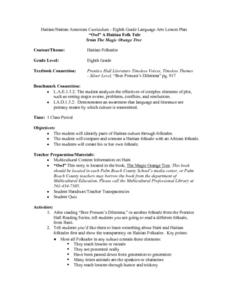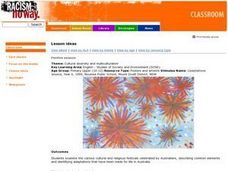Curated OER
Cinderbank
Fourth graders identify major components of a "Cinderella" story in order to create a database.
Curated OER
"Kookie Kitties" - Paul Klee: Finger Puppets
Students examine and discuss the painting, Cat and Bird, by Paul Klee. They identify the various types of lines, shapes, and colors in the painting, and design and create finger puppet versions of the animals from the painting.
Curated OER
Dancing Feathers
Fifth graders read and analyze the novel, 'Dancing Feathers.' They identify the main story elements, develop personal and fictional narratives, retell the story from a different point of view, create a mask, and design a postcard.
Curated OER
Charlotte's Web
Students complete a variety of activities related to the book "Charlotte's Web" by E.B. White. They create a comic strip based on the characters, setting, and plot of the story, and examine the author's writing process. In small groups...
Curated OER
LA CENERENTOLA (Cinderella)
Students research Cinderella stories from different cultures. They explore how words, like opera, can tell a story. Students identify the unique cultural elements of various versions of the Cinderella story. identify aspects of Students...
Curated OER
An Introduction to the Relationship Between Composition and Content in the Visual Arts
Students identify different kinds of narratives used in a number of art works, discuss artist's use of compositional elements to further the story and/or convey a message within a work of art, and explain relationship between composition...
Curated OER
Cultural Creation Myths
Students write original plays based on supernatural explanations of existence. In this cultural creation myths lesson, students listen to five different stories about supernatural creation. Students record similarities and differences in...
Curated OER
Is This a House for Hermit Crab?
First graders identify text that uses sequence or other logical order. They identify and interpret how different plants and animals inhabit different kinds of environments and have external features that help them thrive in different...
Curated OER
Jack and the Beanstalk
Third graders read a story and grow a beanstalk. In this literature and life science lesson, the class reads "Jack and the Beanstalk," then lists fairy tale elements and write a puppet show. The students plant pinto beans and observes...
Curated OER
Dr. Seuss
Students read books by the same author and compare what they find. In this Dr. Seuss lesson, students learn about Dr. Seuss' writing style, listen for the rhyme scheme in his stories, and create a KWL chart on Dr. Seuss. ...
Curated OER
Splendid China: Chinese Folktales
Students investigate Chinese culture by reading their folk tales. In this creative writing lesson, students practice identifying the different elements in a folk tale and examine the related vocabulary. Students organize...
Curated OER
Haunting Music
Young scholars discover music that was inspired by the spooky and bizarre. For this music of Hector Berlioz and Camille Saint-Saens lesson, students identify elements of music and listen to the Symphonie Fantastique and Danse...
Curated OER
Literature: Esperanza Rising
Students read and discuss the book, Esperanza Rising. After analyzing and identifying the novel's structural elements, they examine working conditions for migrant workers in the 1930s. As part of the lesson, students in groups choose...
Curated OER
"Me and My Family Tree"
Students explore genealogy by reading a family history book in class. In this family tree lesson, students read the story Me and My Family Tree by Joan Sweeney and discuss their own family history. Students identify what the term...
Curated OER
Characterization
Students read the book Sylvester and the Magic Pebble. In this character traits instructional activity, students read the book and identify character traits. Students draw pictures of a character from the book and describe the character...
Curated OER
Folktale Quilt
Students read several selections of folktales from different historic periods and different cultures. Then they incorporate a folktale theme into a modern day story, using elements that parallel those from the original version.
Curated OER
Birth and Early Childhood
Eighth graders read and compare creation stories of different cultures around the world. They identify and define the concept of the cycle of life and collect and analyze birth and childhood folk beliefs and stories in their families...
Curated OER
TELL THE SEQUENCE IN AN ORAL REPORT
Second graders survey a favorite story he/she has read or heard read aloud. They use the graphic organizer to draw illustrations that show the beginning, middle and end of the story. They tell the title of the story, whether it is...
Curated OER
"Owl" A Haitian Folk Tale
Eighth graders read and discuss the Haitian folktale, "Owl." They compare it to the story, "Brer Possum's Dilemma," using a Venn diagram to show how they are different and alike. In groups, they retell the story in a skit format.
Curated OER
Map Your State: Regions of Arizona
Fourth graders define vocabulary and locate physical features on maps. In this mapping lesson, 4th graders explore regions of Arizona through landforms found on topographic maps. Students research the history and culture of...
Developing a Global Perspective for Educators
The Lorax - Language
First graders identify text features and how they communicate meaning to the reader. In this media literacy instructional activity, learners view the movie The Lorax and discuss how students from another country would respond to this...
Curated OER
Bag It
Students create a book report in a bag. They include items that explain the elements of the story and share them with the class.
Curated OER
Festive Season
Students research various cultural and religious festivals celebrated and observed by Australians, describing common elements and identifying adaptations that have been made for life in Australia.
Curated OER
Native American Basket Making
Students design a unique basket plaque incorporating at least one symbol from their chosen tribe. They also identify, share, and give rationales for the symbols in basket plaques. Whole class discussion jig-saws their discoveries.

























